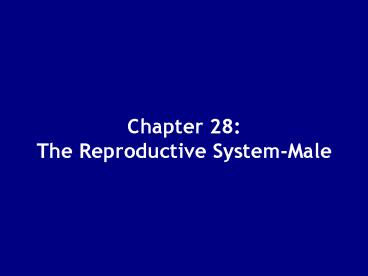Chapter 28: The Reproductive System-Male - PowerPoint PPT Presentation
1 / 27
Title: Chapter 28: The Reproductive System-Male
1
Chapter 28 The Reproductive System-Male
2
The Reproductive System
- Gonads
- organs that produce gametes and hormones
- Ducts
- receive and transport gametes
- Accessory glands
- secrete fluids into ducts
- Perineal structures
- collectively known as external genitalia
3
Male Female Reproductive Systems
- Are functionally different
- Female produces 1 gamete per month
- retains and nurtures zygote
- Male disseminates large quantities of gametes
- produces 1/2 billion sperm per day
4
The Male Reproductive System
- Testes or male gonads
- secrete male sex hormones (androgens)
- produce male gametes (spermatozoa or sperm)
- Emission
- mature spermatozoa move along duct system
- Semen
- sperm mixed with accessory gland secretions
- Ejaculation
- semen expelled from body
5
What are the components of the male reproductive
system?
6
The Male Reproductive System
Pathway of Spermatozoa
- Testis
- Epididymis
- Ductus deferens (vas deferens)
- Ejaculatory duct
- Urethra
Figure 281
7
Accessory Organs
- Secrete fluids into ejaculatory ducts and
urethra - seminal vesicles
- prostate gland
- bulbourethral glands
8
External Genitalia
- Scrotum
- encloses testes
- Penis
- erectile organ
- contains distal portion of urethra
9
Testis
- Is egg-shaped
- 5 cm long, 3 cm wide, 2.5 cm thick
- Weighs 1015 g
- Hangs in scrotum
The Scrotum
- Is a fleshy pouch
- Suspended infer
- ior to perineum
- Anterior to anus
- Posterior to base of penis
10
The Fetus Formation of Testes
- Testes form inside body cavity
- are adjacent to kidneys
The Fetus Gubernaculum Testis
- Is a bundle of connective tissue fibers
- Extends from testis to pockets of peritoneum
- Locks testes in position (near anterior abdominal
wall) as fetus grows
11
Structure of the Testes
Figure 284
12
Structures of Testes
- Septa subdivide testis into lobules
- Lobules contain about 800 slender and
tightly-coiled seminiferous tubules
13
Seminiferous Tubules
- Produce sperm
- Each is about 80 cm long
- Testis contains about 1/2 mile of tightly-coiled
seminiferous tubules
- Each forms a loop connected to rete testis
14
The Epididymis
Figure 289
15
Sperm Maturation
- Testes produce physically mature spermatozoa that
can not fertilize an oocyte - Other parts of reproductive system are
responsible for - functional maturation, nourishment, storage, and
transport
- Spermatozoa
- detach from sustentacular cells
- are free in lumen of seminiferous tubule
- are functionally immature
16
The Epididymis
- Is the start of male reproductive tract
- Is a coiled tube almost 7 m long
- bound to posterior border of testis
3 Functions of the Epididymis
- Monitors and adjusts fluid produced by
seminiferous tubules - Recycles damaged spermatozoa
- Stores and protects spermatozoa
- facilitates functional maturation
17
Spermatozoa Leaving Epididymis
- Are mature, but remain immobile
- To become motile (actively swimming) and
functional spermatozoa undergo capacitation
2 Steps in Capacitation
- Spermatozoa become motile
- when mixed with secretions of seminal vesicles
- Spermatozoa become capable of fertilization
- when exposed to female reproductive tract
18
The Ductus/Vas Deferens and Accessory Glands
Figure 2810a, b
19
The Ductus/Vas Deferens and Accessory Glands
Figure 2810a, e
20
The Ductus/Vas Deferens
- Also called vas deferens
- Can store spermatozoa for several months
- in state of suspended animation (low metabolic
rates) - Is 4045 cm long
- Begins at tail of the epididymis
- Ascends through inguinal canal
- as part of spermatic cord
21
The Ejaculatory Duct
- Is a short passageway (2 cm)
- at junction of ampulla and seminal vesicle duct
- Penetrates wall of prostate gland
- Empties into urethra
22
The Male Urethra
- Is used by urinary and reproductive systems
- Extends 1820 cm
- from urinary bladder to tip of penis
- Is divided into 3 regions
- prostatic
- membranous
- spongy
23
4 Major Functions of Male Glands
- Activating spermatozoa
- Providing nutrients spermatozoa need for motility
- Propelling spermatozoa and fluids along
reproductive tract - mainly by peristaltic contractions
- Producing buffers
- to counteract acidity of urethral and vaginal
environments
24
The Prostate Gland
- Is a small, muscular organ, about 4 cm diameter
- Encircles proximal portion of urethra below
urinary bladder
Prostatic Fluid
- Is slightly acidic
- Forms 2030 of semen volume
- Contains antibiotic seminalplasmin
- Is ejected into prostatic urethra
- by peristalsis of prostate wall
25
The Penis
Figure 2811a, b
26
5 Functions of Testosterone
- Stimulates spermatogenesis
- promoting functional maturation of spermatozoa
- Affects CNS function
- libido (sexual drive) and related behaviors
- Stimulates metabolism
- especially protein synthesis, blood cell
formation and muscle growth
- Est. male secondary sex characteristics
- distribution of facial hair
- increased muscle mass and body size
- characteristic adipose tissue deposits
- Maintains accessory glands and organs
27
Testosterone and Development
- Testosterone production
- begins around seventh week of fetal development
- reaches prenatal peak after 6 months
- Secretion of Müllerian inhibiting factor
- by sustentacular cells
- leads to regression of Müllerian ducts
- Early surge in testosterone levels
- stimulates differentiation of male duct system
and accessory organs - affects CNS development
- Testosterone programs hypothalamus, controlling
- GnRH, FSH, and LH secretion
- sexual behaviors
- sexual drive































